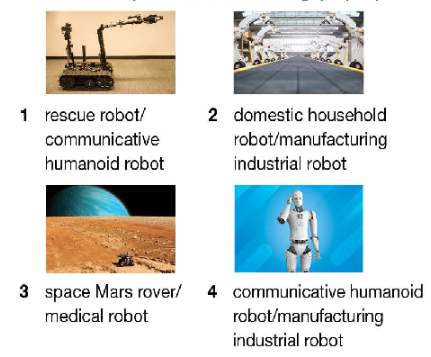Giải SGK, SBT Unit 7. Artificial intelligence Bright
Giải SGK, SBT Unit 7 Bright
Reported Speech (statement & questions) (Câu gián tiếp (câu khẳng định và câu hỏi))
We use reported speech to report what someone said.
(Chúng ta dùng câu trần thuật để tường thuật những gì người khác nói.)
When we change direct speech to reported speech:
(Khi chúng ta đổi từ dạng trực tiếp sang gián tiếp:)
• For statements, use reporting verbs said/ said to/told to report what people said in the past.
(Với câu khẳng định, dùng các động từ tường thuật như said/ said to/told để kể lại những gì người khác nói trong quá khứ.)
Phoebe said to me, "I find AI very interesting."
→ Phoebe said/said to me/told me (that) she found AI very interesting.
(Phoebe nói với tôi rằng cô ấy thấy AI rất thú vị.)
• For Yes/No questions, use asked and if/ whether to report questions.
(Với câu hỏi Đúng/Sai, dùng asked và if/whether để tường thuật câu hỏi.)
"Have you ever used an AI app?" he asked me.
→ He asked me if/whether I had ever used an AI app.
(Anh ta hỏi tôi liệu tôi đã bao giờ sử dụng ứng dụng AI chưa.)
• For Wh-questions, use the same question words as in the direct questions.
(Với câu hỏi có từ hỏi Wh-, dùng đúng từ hỏi trong câu hỏi trực tiếp.)
"Where did you download your navigation app from?" he asked me.
→ He asked me where I had downloaded my navigation app from.
(Anh ta hỏi tôi rằng tôi đã tải ứng dụng chỉ đường ở đâu.)
• Change the subject pronouns, object pronouns, possessive adjectives and time words/expressions.
(Đổi các đại từ chủ ngữ, đại từ tân ngữ, tính từ sở hữu và các từ chỉ thời gian.)
"I will show you how to use the assistant tomorrow," Joe said to me.
→ Joe said to me (that) he would show me how to use the digital assistant the following day.
(Joe nói với tôi rằng anh ta sẽ cho tôi thấy cách dùng trợ lí ảo vào ngày mai.)
• Change the verb tenses:
(Đổi thì của động từ:)
|
Direct Speech (Trực tiếp) |
Reported Speech (Gián tiếp) |
|
present simple (hiện tại đơn) |
past simple (quá khứ đơn) |
|
present continuous (hiện tại tiếp diễn) |
past continuous (quá khứ tiếp diễn) |
|
past simple (quá khứ đơn) |
past perfect (quá khứ hoàn thành) |
|
past perfect (quá khứ hoàn thành) |
past perfect (quá khứ hoàn thành) |
|
am/is/are + going to |
was/were + going to |
|
will, can, may, must, have to |
would, could, might, had to |
We keep the verb tenses when: (Chúng ta giữ nguyên thì của động từ khi:)
• The reporting verb is in the present simple, future or present perfect tense.
(Động từ tường thuật ở thì hiện tại đơn, tương lai hoặc hiện tại hoàn thành.)
I like AI apps," Jo says.
→ Jo says (that) he likes AI apps.
(Joe nói rằng anh ấy thích những ứng dụng AI.)
• The direct speech is in conditionals type 2 or type 3.
(Lời nói trực tiếp trong câu điều kiện loại 2 và loại 3.)
Tom said to Mary, “If I were you, I would buy that speaking coach app.”
→ Tom said to Mary (that) if he were her, he would buy that speaking coach app.
(Tom nói với Mary rằng nếu anh là cô ấy thì anh sẽ mua ứng dụng luyện nói.)
1. Choose the correct option. (Chọn đáp án đúng.)
1. Sebastian said that he _____ an interesting article about rescue robots the day before.
A. would read B. read C. has read D. had read
2. Tammy said that she was going to attend a seminar on AI technology _____.
A. tomorrow B. the next day C. the previous day D. yesterday
3. Greg asked Paul why he had deleted the diet tracker app _____.
A. today B. yesterday C. the day before D. a day ago
4. Amanda says that her factory _____ using manufacturing industrial robots the following month.
A. will start B. had started C. would start D. was starting
5. Oliver asked me whether I _____ to the robotics convention that weekend.
A. would go B. went C. had gone D. have gone
1. Listen to five people talking about AI-powered robots. Match the speakers (1-5) to the robots (a-e).
(Lắng nghe năm người nói về rô bốt trang bị AI. Nối các người nói (1-5) với các loại rô bốt (a-e).
|
1. ___ Arthur 2. ___ Sam 3. ___ Connor 4. ___ Phoebe 5. ___ Angie |
a. rescue robot b. manufacturing industrial robot c. medical robot d. space Mars rover e. domestic household robot |
Vocabulary (Từ vựng)
AI gadgets (Các tiện ích AI)
1. Match the gadgets (1-4) to their definitions (a-d).
(Nối các tiện ích (1-4) với định nghĩa của chúng.)
|
1. ___ digital home assistant 2. ___ language translator 3. ___ security system 4. ___ fitness tracker |
a. a device that protects a house or a building and alarms the owner if someone breaks in. b. a device that records a person's daily activities. c. a device that responds to voice commands d. a programme that converts one language into another |
3. Match the words in the two columns.
(Nối các từ trong hai cột.)
|
1. ___ extremely 2. ___ maximum 3. ___ highly 4. ___ reliable 5. ___ user |
a. efficiency b. experience c. choice d. recommend e. expensive |







